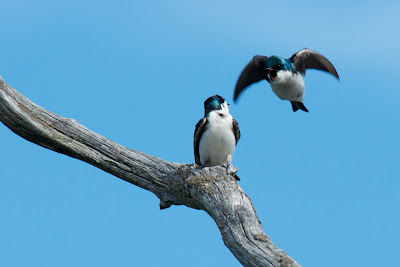I dashed upstairs and came face-to-face
with a ghost bird.
Well, it was the image of a
ghost at least. The near-perfect silhouette of a Mourning Dove was etched onto
our picture window.
Another window strike. This
is a too-common way for birds to meet their end. It's estimated that millions of
birds die each year when they smash into windows. Exact numbers are impossible
to tabulate.
At our feeding station, the
common precipitate for window strikes is the resident Cooper's Hawk, or his
associate, a Red-shouldered Hawk that's also been working the area with
frequency. I can't blame the hawks, they have to eat, too. When one of the
raptors flies in, or over, it's mayhem at the feeders; birds take off in all
directions, and our large picture window reflects an escape route into the
forest.
What to do?
Birding buddies Pat and
Karin found a solution to the window-strike problem at their home. Over the
years they tried several devices that were not acceptable, i.e. screening
devices that cut the viewing of birds to an unacceptable level.
Pat discovered the Acopian
Bird Savers, a clever
array consisting of single dark-colored nylon cords hung vertically a few inches
in front of the outside window glass. These nylon cords are spaced about
four inches apart across the horizontal width of the window.
The idea is, birds used to flying through the woods can avoid
branches. The presumption is, they recognize these dark nylon cords as dark
branches. The Acopian Center for Ornithology at Muhlenberg College and Dr.
Daniel Klem, Jr. developed and refined this tactic using field tests in a
wooded opening in a Pennsylvania forest. It's good science. The result was the
nylon-corded windows reduced window strikes by upwards of 90 percent compared
with unprotected windows.
If
you’d like to save the lives of more than a few birds, here are a couple links
to explore:
Now,
to get that ghostly image off the window, I’ll need the stepladder, the glass
cleaner, the … Or, I could just call GhostBusters!


















